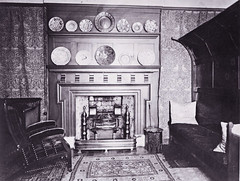I
n 1862, Morris, Marshall, Faulkner & Co. began to advertise 'Painted Earthenware including wall Tiles with pictured subjects, figures or patterns'. Blank tiles imported from Holland were hand-painted, often by the wives and sisters of the partners, before being refired at the company’s first premises at 8 Red Lion Square, London.
"The great advantage and charm of the Morrisian method is that it lends itself to either simplicity or splendour."
Walter Crane, 1911
Sought-after for artistic wall and fireplace decoration, Morris tiles were painted in-house until 1873, when employee William De Morgan established his own ceramics design and manufacture business. Continuing to collaborate closely with Morris, De Morgan became a major supplier to Morris & Co. (as it was known from 1875), and his wares became part of an integrated Morris 'look'. De Morgan became well-known for his Persian-inspired tiles and vessels, many of which made use of his rediscovered early Islamic lustre glazing techniques.

As British artist Walter Crane commented in 1911, 'The great advantage and charm of the Morrisian method is that it lends itself to either simplicity or splendour. You might almost be as plain as Thoreau, with a rush-bottomed chair, a piece of matting, an oaken trestle table; or you might have gold and lustre (the choice ware of William De Morgan) gleaming from a sideboard, and jewelled light in the windows, and the walls hung with arras tapestry.'

